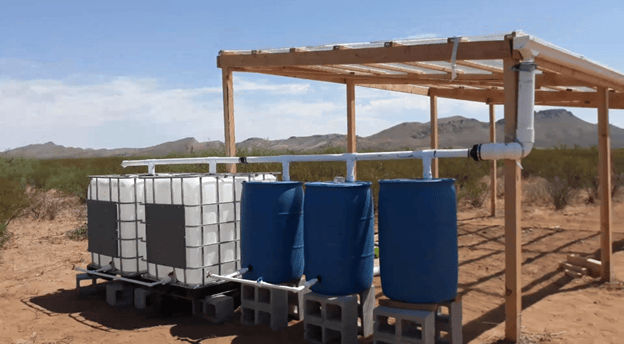Rainwater Harvesting: Transforming Raindrops into a Valuable Resource
Rain water harvesting!
12/16/20244 min read


Rainwater Harvesting: Transforming Raindrops into a Valuable Resource
In an era of increasing water scarcity and growing environmental consciousness, rainwater harvesting has emerged as a practical and sustainable solution for homeowners and homesteaders alike. This innovative approach to water management not only reduces reliance on municipal water supplies but also provides numerous environmental and economic benefits.
Understanding Rainwater Harvesting
Rainwater harvesting is the collection and storage of rainwater for reuse on-site, rather than allowing it to run off. The process typically involves capturing rainwater from rooftops, storing it in tanks or cisterns, and then using it for various non-potable and, with proper treatment, potable purposes.
Key Components of a Rainwater Harvesting System
1. Collection Surface
The most common collection surface is a roof. Typically, metal, tile, or asphalt shingle roofs work best. The larger the roof area, the more water you can potentially collect. A basic calculation shows that for every inch of rain on a 1,000 square foot roof, you can collect approximately 623 gallons of water.
2. Gutters and Downspouts
These are critical for directing water from the roof to your storage system. Ensure they are clean, properly aligned, and free from debris. Consider installing leaf guards to prevent contaminants from entering your collection system.
3. First Flush Diverter
This important component helps remove initial runoff that contains dirt, leaves, and potential contaminants. By diverting the first few gallons of rainfall, you improve the overall water quality of your harvested rainwater.
4. Storage Tanks
Storage options range from simple rain barrels to large underground cisterns. When selecting a tank, consider:
- Local climate and rainfall patterns
- Available space
- Water usage needs
- Budget constraints
Practical Applications for Harvested Rainwater
Landscape Irrigation
One of the most common uses of harvested rainwater is landscape irrigation. This can significantly reduce your reliance on municipal water and lower water bills, especially during dry seasons.
Livestock and Agricultural Use
For homesteaders, rainwater can be an excellent water source for:
- Watering livestock
- Irrigation of gardens and small-scale crops
- Filling livestock drinking troughs
Indoor Non-Potable Uses
With proper filtration, harvested rainwater can be used for:
- Toilet flushing
- Laundry
- Cleaning
System Design Considerations
Legal Considerations
Before installing a rainwater harvesting system, check local regulations. Some areas have specific guidelines or even incentives for rainwater collection.
Water Quality and Treatment
The level of treatment depends on your intended use:
- Landscape irrigation: Minimal filtration needed
- Livestock: Basic filtration recommended
- Indoor non-potable use: More advanced filtration
- Potable use: Requires comprehensive treatment including UV sterilization, multi-stage filtration, and regular water quality testing
Cost and Return on Investment
Initial setup costs for a rainwater harvesting system can range from $500 for a basic barrel system to $10,000 or more for comprehensive underground cistern setups. However, potential savings include:
- Reduced water bills
- Lower irrigation costs
- Potential tax incentives
- Increased property value
Environmental Benefits
Beyond personal advantages, rainwater harvesting contributes to:
- Reduced stormwater runoff
- Decreased erosion
- Groundwater recharge
- Lower demand on municipal water systems
Maintenance Tips
To ensure your system remains effective:
- Clean gutters and screens regularly
- Inspect tanks for sediment buildup
- Check filtration systems
- Monitor water quality periodically
- Winterize systems in cold climates
Types of Rainwater Harvesting Systems
Rainwater harvesting is not a one-size-fits-all solution. Different environments, climates, and property characteristics call for various system designs. Here's an in-depth look at the most common rainwater harvesting approaches:
1. Rooftop Rainwater Harvesting Systems
A. Simple Barrel Collection System
Description: The most basic and affordable option
Components:
- Large rain barrel connected to a downspout
- Typically 50-100 gallon capacity
- Ideal for small gardens or limited water needs
Best For:
- Urban homes with small outdoor spaces
- Gardeners with limited irrigation requirements
- Budget-conscious homeowners
B. Advanced Rooftop Collection System
Description: Comprehensive setup with multiple storage tanks and filtration
Features:
- Large underground or above-ground cisterns
- Multi-stage filtration system
- Pump for distributed water usage
- Capacity ranging from 500 to 10,000 gallons
Suitable For:
- Large properties
- Homesteads with extensive irrigation needs
- Homes seeking significant water independence
2. Landscape-Integrated Rainwater Harvesting
A. Contour Swale Systems
Description: Landscape design that captures and directs rainwater
Characteristics:
- Shallow, sloped trenches following land contours
- Slows water runoff
- Promotes ground absorption
Benefits:
- Natural water management
- Reduces erosion
- Supports landscape vegetation
B. Rain Gardens
Description: Strategically planted depression that collects and filters rainwater
Components:
- Specially selected native plants
- Engineered soil mix
- Natural filtration system
Advantages:
- Aesthetic landscape feature
- Reduces runoff
- Supports local ecosystem
3. Catchment Systems for Different Terrains
A. Rural Homestead Large-Scale Collection
Description: Comprehensive water collection from multiple surfaces
Collection Surfaces:
- Barn roofs
- Greenhouse structures
- Equipment storage buildings
Storage Solutions:
- Large concrete or metal cisterns
- Multiple interconnected tanks
- Gravity-fed distribution systems
B. Hillside and Sloped Property Systems
Description: Specialized systems for properties with significant elevation changes
Unique Features:
- Terraced collection points
- Gravity-assisted water movement
- Multiple collection and storage zones
4. Advanced Technology Integration
A. Smart Rainwater Harvesting Systems
Description: Technology-enhanced water collection and management
Technologies:
- Automated filtration systems
- Real-time water quality monitoring
- Smart pumps with usage tracking
Benefits:
- Precise water management
- Automatic system optimization
- Detailed water usage insights
B. Solar-Powered Rainwater Systems
Description: Renewable energy-powered water collection and distribution
Components:
- Solar panels
- Electric pumps
- Battery storage
Advantages:
- Off-grid capabilities
- Reduced electricity costs
- Environmentally friendly operation
Choosing the Right System
When selecting a rainwater harvesting system, consider:
- Local annual rainfall
- Property size and layout
- Water usage requirements
- Budget constraints
- Local building codes and regulations
System Cost Breakdown
Basic Barrel System
- Initial Investment: $100 - $500
- Annual Water Savings: 30-50%
Advanced Rooftop System
- Initial Investment: $5,000 - $15,000
- Annual Water Savings: 50-80%
Comprehensive Homestead System
- Initial Investment: $15,000 - $30,000
- Annual Water Savings: 70-90%
Maintenance Recommendations by System Type
1. Barrel Systems
- Monthly cleaning
- Annual thorough inspection
- Winter drainage in cold climates
2. Advanced Rooftop Systems
- Quarterly filtration checks
- Biannual tank cleaning
- Regular pump maintenance
3. Landscape Integrated Systems
- Seasonal plant maintenance
- Annual soil and drainage assessment
- Monitor for erosion or blockages
Conclusion
The diversity of rainwater harvesting systems ensures that nearly every property can benefit from this sustainable water management approach. From simple rain barrels to sophisticated, technology-integrated solutions, there's a system designed to meet virtually every need and budget.
By understanding the various options and carefully assessing your specific requirements, you can implement a rainwater harvesting system that not only conserves water but also provides long-term environmental and economic benefits.
